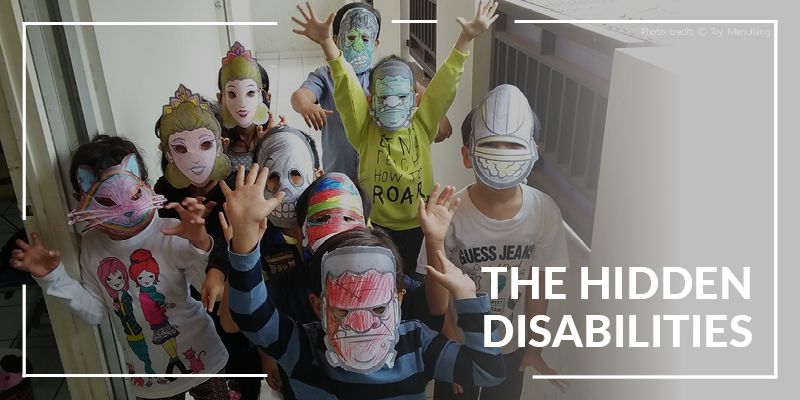Educate ourselves about learning disabilities to ensure right to education
More than one billion people around the world have some form of disability, 93 million of whom are children under the age of 14, according to WHO data. Some of the most common and often seriously neglected forms of childhood disabilities are learning disabilities, often termed “hidden disabilities” that are not easily identified, as opposed to physical disabilities. In Thailand, an estimated 40,000 children born every year could have some form of learning disability, most commonly dyslexia. However, there is often limited information on children with learning disabilities and the impact on learning outcomes, with many countries in the Asia-Pacific region facing challenges in responding to the needs of these children.
“There are a few misconceptions. [Learning disabilities] are typically associated with low IQ, and they are caused by cultural, environmental or economic factors, laziness and lack of motivation, perceptual and motor disabilities – No,” said Dr Anat Ben-Simon, CEO of Israel’s National Institute for Testing and Evaluation. “[And do] learning disabilities fade with time? Absolutely not.”
Learning disabilities (LD) refer to a group of disorders that interfere with the acquisition and use of speaking, reading, writing or basic mathematical abilities. These disorders affect individuals who otherwise demonstrate at least average abilities for thinking or reasoning.
“LD is diagnosed when difficulties in one of the areas – reading, spelling, grammar, calculation, mathematical reasoning – last for at least six months despite tailored help,” Dr Ben-Simon said. “Dyslexia, dysgraphia and dyscalculia – these are typical forms of LD. Dyslexia is an impairment in reading, dysgraphia an impairment in written expression, and dyscalculia is an impairment in mathematics. The symptoms for each of dyslexia, dysgraphia and dyscalculia tend to closely overlap each other, making them difficult to properly diagnose. For example, many kids with dysgraphia also have dyslexia, and vice versa.”
Further complicating diagnosis is the neuro-developmental disorder Attention Deficit and Hyperactivity Disorder (ADHD), which is a combination of impaired cognitive skills, such as attention, speed of processing, memory, perception, executive functions and reasoning. “There are major overlaps between these disorders,” Dr Ben-Simon said. “If you suspect there are issues like mental and emotional problems, you have to assess them and see on what degree it causes learning disabilities.”
According to the International Dyslexia Association, children with dyslexia more often than not suffer from ADHD. IDA data also show that roughly 30% of children with ADHD have learning difficulties to a certain degree. In fact, some children may act up and get frustrated to cover their reading difficulties, which may lead to them being misdiagnosed with only ADHD, overlooking their mild to moderate dyslexic condition.
Proper diagnosis of each student’s disability is essential for providing proper support for learning assessing learning outcomes. “When I first started my teaching career, I did not know that students with LD exist. I used to think that they must be lazy students as they kept making mistakes in writing and reading simple word such as ‘school’. Our inability in knowing or diagnosing students with LD might cause us to think that they are lazy and troublesome students,” said Ms Try Manoellang, a schoolteacher from Indonesia. “Had I not studied the Special Education programme, I might not be able to identify my students with LD and keep on thinking they are lazy students.” Methods of diagnosis include academic and cognitive tests, review of children’s developmental history, documented school achievements, previous diagnostic reports and personal interview results.
However, diagnosis is only the first stage. Understanding how to accommodate these learners, both in and outside of the classroom, and to measure their learning outcomes is also critical. “Test accommodations should meet three principles: effectiveness and fairness, validity and comparability,” Dr Ben-Simon said.
“There are considerations such as examinee factors (eg, the degree/severity of LD), test/task factors (eg, the purpose of test/assignment), and cost-applicability factors (eg, cost-effectiveness of the intervention/accommodation) to select what accommodation types will suit students with LD,” Dr Ben-Simon said.
Accommodating students with learning disabilities requires a very detailed process, from diagnosis to assessment, using a variety of tools. In many cases, this might be too complicated for busy, overwhelmed schoolteachers, making it important that both teachers and students with special needs have professionals working at the school level to support them with diagnosis of learning disabilities and to provide reasonable accommodations for learning and testing.
Schoolteacher Ms Manoellang highlighted the importance of collaboration between teachers and specialists in the field of diagnosing and assessing disabilities. “Although I have studied it, I still have to discuss my diagnosis of the student with parents and the academic team and encourage parents to consult with a psychiatrist, as I am aware that I may make a mistake. Therefore, educating parents, teachers and school staff is essential if we want to accommodate our students’ learning needs in order to ensure their quality learning.”
At UNESCO Bangkok, the Network on Education Quality Monitoring in the Asia-Pacific (NEQMAP) works with countries and education stakeholders to build strong linkages between curriculum, pedagogy and student learning assessments in order to monitor education quality and learning outcomes. UNESCO and NEQMAP are continuing to work with countries to support the tools, knowledge and capacity needed to improve quality-learning outcomes for students with learning disabilities. As the 1948 Universal Declaration of Human Rights states, “everyone has a right to education”.
by Rina Akiyama, a former schoolteacher and intern at UNESCO Bangkok.
Mark Manns, a programme officer for Inclusive Quality Education at UNESCO Bangkok.
*This article was originally published in The Nation









